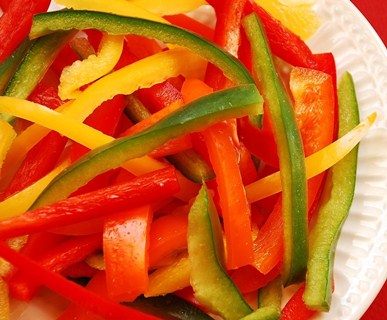50-Minute Classroom: How to Buy Knives, Part 3
30 November 2010By Adam Weiner
 Chef Weiner continues his advice for students on knife selection and maintenance. This month: properly using knives.
Chef Weiner continues his advice for students on knife selection and maintenance. This month: properly using knives.
Over the last two months, these articles were written in handout format for your students regarding how to buy knives/how knives are made, and how to hone and sharpen knives. Again, as a handout, this month’s article is about using knives. Next month, the last part of this series, will be on how to care for knives.
Using Knives
Here’s the bad news: You can’t learn how to use a knife from reading a handout, any more than you can learn how to drive a car by playing a computer game. With that said, there are a number of good Web sites on the subject, such as www.hertzmann.com, particularly, “The Three Aspects of Knife Skills.”
Sooner, rather than later, you will need to get a knife mentor who can show you how to use knives safely and correctly. However, just because someone claims to be a chef doesn’t mean that he or she is good with knives. Make sure your knife mentor has good technique, so that you avoid learning bad knife habits. The best way to do this is to compare his/her technique with the Web site mentioned above, or with techniques demonstrated in textbooks. When in doubt, ask your culinary instructor to verify that your knife mentor is teaching you the correct techniques.
To start out, there are a few general rules that you need to follow:
A. Stand Comfortably
Your work table should be at waist level, and you should stand comfortably in front of the board. Bending over, straining to cut too high, etc., are signs of bad position and bad ergonomics. You want to work comfortably, or else your knife technique will not be good.
B. Use a Steel
See 50-Minute Classroom: How to Buy Knives, Part 2, published in November.
C. Only Use a Wooden or Plastic Cutting Board
Never cut on glass, metal, ceramic, inside pots or pans, on serving plates, etc. These surfaces will dull your knife and, more importantly, are more likely to have the knife slip and cut you. There will always be a temptation to cut on a work table or upon food inside a hotel pan. Unless you want the nickname “Stubby,” avoid that temptation.
D. Put a Slightly Damp Towel under the Cutting Board
This will keep the board from rocking or moving, making cutting easier and your cuts more uniform.
E. Gently Rock the Knife
For most prep cutting, your knife should rock up and down in one place. The tip of the knife will be on the board, and you will lift the knife handle up and let gravity pull it down while you slide the knife forward through the food. You do not chop up and down. The knife stays in the same position on the board. IF YOU CAN HEAR THE KNIFE ON THE BOARD, THEN YOU ARE DOING IT WRONG.
F. Curve Your Fingers and Push the Food to the Knife
Again, don’t move the knife on the board; it just goes back and forth in the same position. If you are right-handed, hold the knife in your right hand and make a claw with your left hand—fingers down. Making sure that your thumb is out of the way, move the food toward the knife, holding the food in place with the fingertips of your clawed hand. For many forms of knife work, you will be bringing the knife down so that its side will be brushing against your first knuckle. If your fingers are curved back, you won’t cut your fingernail or the tip of your finger.
G. Always Keep Your Eyes on Your 10 Fingers
Even if a rock star, President of the United States or a super model walks into your kitchen, keep your eyes on your fingers at all times. If your favorite actor or actress comes into the kitchen stark naked, you carefully set down your knife, parallel to the board with the blade facing away. Only then can you scream, yell, faint or demand an autograph. After that, you can pick up the knife and start again.
H. Hold the Knife Correctly
Your thumb and forefinger should be on either side of the back of the blade, and your three remaining fingers hold the handle gently. Don’t have all five fingers on the handle. Don’t have one finger on top of the knife with the others on the handle.
Chef Adam Weiner teaches a 20-week Introduction to Cooking program for JobTrain and the Sequoia Adult School on the San Francisco Peninsula.
Photo: http://www.dreamstime.com/stock-photography-sliced-pepper-salad-rimagefree7980072-resi1793763
